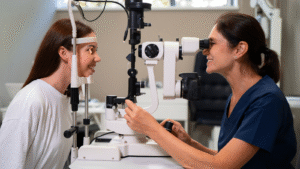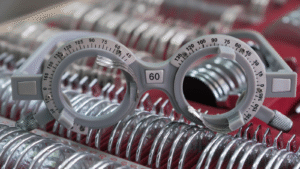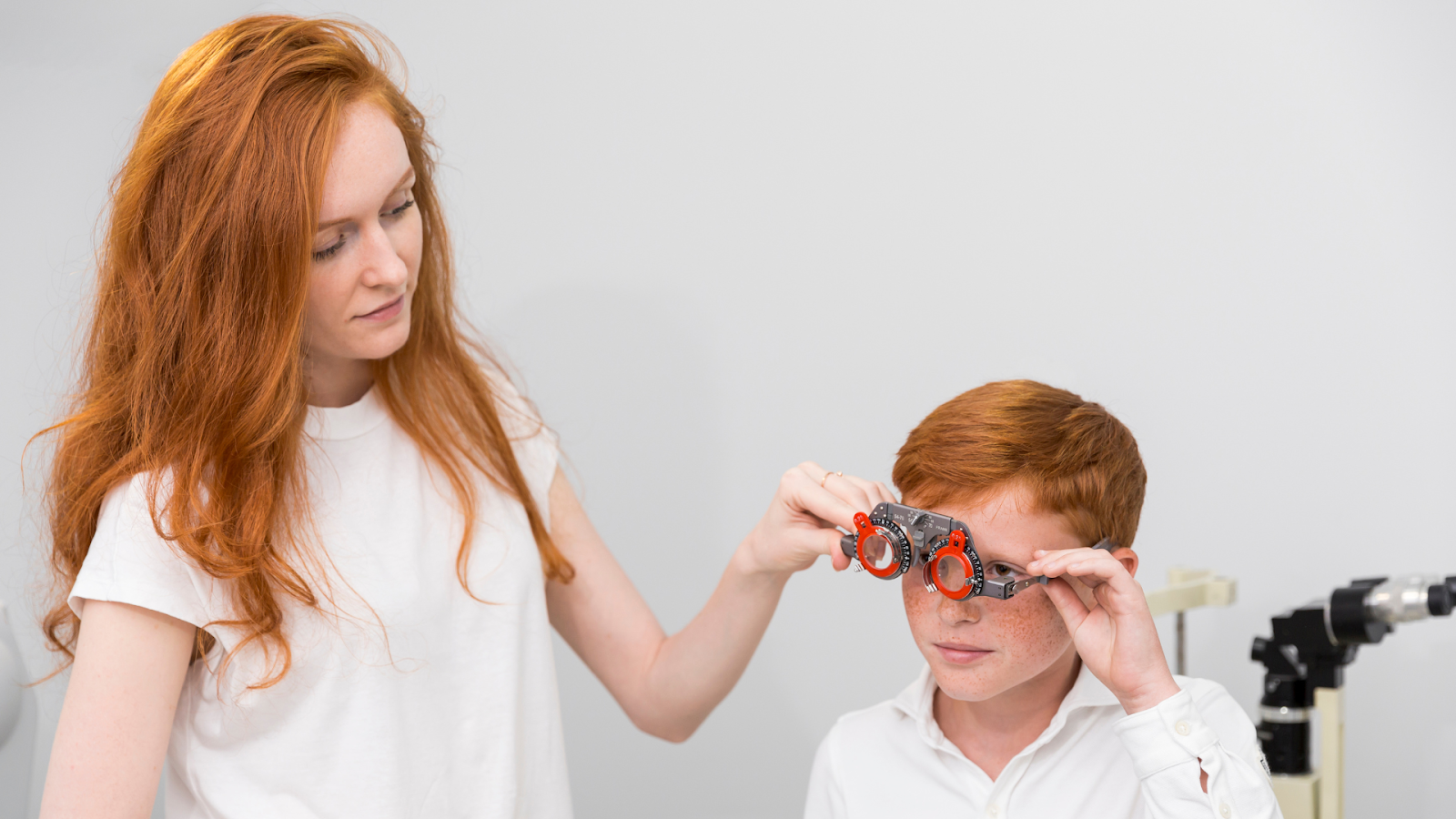Millions of people worldwide experience refractive errors. According to the World Health Organization (WHO), approximately 2.2 billion people globally suffer from uncorrected poor vision.
The two main types, myopia and hypermetropia, are often confused with each other. One affects distance vision, while the other impacts close-up vision. Understanding these differences is crucial for selecting the appropriate corrective method and maintaining eye health.
In this blog, we’ll explain the anatomy of both conditions, their causes, and provide practical solutions. Whether you need to define long-sightedness or understand how short-sightedness impacts daily life, this article will give you the clarity you need.
Key Takeaway
- An elongated eyeball or a steep cornea causes blurry distance vision.
- A shortened eyeball or a flat cornea causes blurry near vision.
- Concave lenses are used for myopia, while convex lenses are used for hypermetropia.
- Eyeglasses, contacts, LASIK/PRK, and vision therapy.
- Myopia is more common in children, while hypermetropia is more common in older adults.
What is Short-Sightedness (Myopia)?
Short-sightedness, or myopia, is a condition where a person sees nearby objects clearly but struggles to see things at a distance. It usually begins in childhood or adolescence and may progress over time.
Key Points
- Caused by an elongated eyeball or a steep cornea, which bends light too sharply.
- Light rays focus in front of the retina, leading to blurred distance vision.
- Common symptoms include difficulty seeing road signs, squinting, and headaches from eye strain.
- Risk factors include genetics, too much screen time, and limited outdoor activity.
Myopia is becoming increasingly common, especially among children in urban environments. Early detection and regular eye exams are crucial for managing its progression.
What is Long-Sightedness (Hypermetropia)?

To clearly define longsightedness, we look at hypermetropia, a condition in which distant objects are typically clear but close-up objects appear blurry. The eye can often compensate by focusing harder, which can lead to eye strain.
Key Points
- Caused by a shortened eyeball or a flat cornea, which results in light focusing behind the retina.
- People can see distant objects more clearly, but their close vision is blurry or uncomfortable.
- Common symptoms include eye fatigue, headaches, and difficulty concentrating on reading or performing detailed tasks.
- Often detected in early childhood or during routine eye exams, especially when children struggle with schoolwork.
To define long-sighted vision, consider it a challenge with near tasks that worsens with age. While young eyes can often adjust, older adults experience more pronounced symptoms due to the lens’s decreased flexibility.
Focus Point Differences
The defining anatomical difference between myopia and hypermetropia is how and where the light is focused inside the eye. This is what causes the variation in visual clarity.
Key Points
- In myopia, light rays focus in front of the retina, causing distant objects to appear blurry.
- In hypermetropia, light rays focus behind the retina, causing nearby objects to appear blurry and difficult to see.
- These focus points are determined by the length of the eyeball and the curvature of the cornea.
When you define long-sighted conditions, it’s crucial to understand that the eye is essentially underpowered for close tasks, whereas in myopia, the eye is overpowered for distance vision.
Also read: Understanding PRK Eye Surgery and Its Process
Vision Clarity Differences
One of the most noticeable differences between long-sightedness and short-sightedness is the ability to see objects at various distances. Understanding these differences can facilitate early diagnosis and effective treatment.
Key Points
- Myopia: Near vision is sharp, but distance vision is blurred. It is ideal for reading or screen use but not for driving or watching TV.
- Hypermetropia: Distance vision is clearer (especially in younger individuals), but close vision requires effort and may be blurry.
- People with long-sightedness may find tasks like reading, sewing, or using smartphones challenging.
- Short-sighted individuals may find everyday tasks, such as recognizing faces or signs, problematic.
If you define long-sighted vision based on clarity, it’s a challenge with anything requiring the eyes to focus closely, especially for extended periods.
Lens Correction Differences

Correcting these conditions involves adjusting how light enters the eye using lenses. The design of the lens depends on whether the eye is too long or too short.
Key Points
- Myopia correction: Uses concave (minus) lenses that spread light rays out, allowing them to land correctly on the retina.
- Hypermetropia correction: Uses convex (plus) lenses that converge light rays sooner so they focus directly on the retina.
- Glasses and contact lenses are the most common solutions.
- Laser surgery can also be used to reshape the cornea for both conditions.
Long-sighted lens correction utilizes convex lenses to compensate for the eye’s inability to focus on nearby objects accurately, thereby reducing eye strain and enhancing clarity.
Prevalence and Contributing Factors
Both conditions are widespread, but they differ in their impact on populations across various age groups and geographic locations.
Myopia
- Highly prevalent worldwide, especially in Asia.
- Affects nearly 30% of adults in many countries.
- Increases in urban areas where children spend more time indoors.
- Progresses with age, especially during puberty.
Hypermetropia
- Common in children and older adults.
- Often undetected in children, as their eyes compensate well.
- Becomes more noticeable with age-related lens hardening (presbyopia).
- Less common than myopia but still a significant cause of visual discomfort.
When professionals define long-sighted trends, they often link them with ageing, while myopia is typically associated with early-life habits and genetics.
Treatment Options
Fortunately, a wide range of treatment options is available for both conditions. The goal is to help light focus correctly on the retina for clearer vision.
1. Eyeglasses
- Most accessible and affordable option.
- Concave lenses correct myopia.
- Convex lenses correct hypermetropia.
- Can be customised for progressive or bifocal needs.
2. Contact Lenses
- Provide a more natural field of vision.
- Require daily cleaning and proper hygiene.
- Available in both soft and rigid gas-permeable options.
3. Refractive Surgery
- LASIK and PRK are common choices.
- Suitable for adults with stable prescriptions.
- Can permanently reshape the cornea for either condition.
- For those who define long-sighted correction through surgery, LASIK effectively reduces dependency on glasses.
Must Read: Comprehensive Guide to Laser Eye Surgery Procedures
4. Vision Therapy
- Helps with eye coordination, especially for individuals with long-sightedness and convergence issues.
- Includes exercises prescribed by optometrists.
5. Orthokeratology (Ortho-K)
- Temporary reshaping of the cornea using overnight lenses.
- Common for myopia control in children and adolescents.
To effectively define long-term treatment, the solution must be tailored to the individual’s age, lifestyle, and the severity of the condition.

Conclusion
Understanding the difference between long-sightedness and short-sightedness goes beyond knowing what’s blurry. It involves learning how your eyes process light, how your vision behaves in different environments, and which treatments can restore clarity.
To recap:
- Myopia causes clear near vision but blurry distance vision.
- Hypermetropia, or long-sighted vision, causes clear distance vision (in mild cases) but blurry close-up vision.
- These conditions differ in structure, symptoms, and treatment.
- You can live a whole, focused life with the proper corrective methods—from glasses to surgery.
If you’re struggling with blurred vision, eye strain, or the limitations of glasses, it might be time to consider your next step. At The Vision Surgeon in Colchester, Mr. Hatch Mukherjee offers expert diagnosis and advanced treatment options — including blade-free, all-laser LASIK surgery for both myopia and hypermetropia.
FAQs
- What’s the difference between long-sightedness and short-sightedness?
Myopia (short-sightedness) causes blurry distance vision, while hypermetropia (long-sightedness) blurs near vision. Myopia is due to an elongated eyeball, and hypermetropia results from a shortened one. - Can both conditions be treated with corrective lenses, such as glasses?
Yes, myopia is corrected with concave (minus) lenses, and hypermetropia with convex (plus) lenses. Both conditions are treated with prescription glasses. - What are the signs of these conditions?
Myopia causes trouble with distance vision, such as reading road signs, while hypermetropia leads to blurry close-up tasks, like reading and using a smartphone. - Is there a permanent solution?
Yes, LASIK and PRK surgeries can reshape the cornea, providing a permanent solution for both conditions. - Why is myopia becoming more common?
Myopia is rising, especially in children, due to increased screen time and less outdoor activity. Early detection is key for management. - Can I prevent these conditions?
While genetics plays a role, reducing screen time, taking breaks, and spending time outdoors may help prevent or slow progression.
